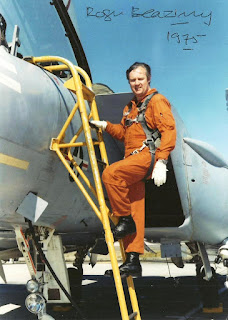Roger H Beazley [RHB] flew his first solo in a Tiger Moth derivative, the Thruxton Jackaroo whilst undergoing an air cadet scholarship in 1959. He subsequently qualified as a gliding instructor within the air cadet movement whilst employed in industry as an electrical engineering draughtsman.
In 1964 he left industry to join
the Royal Air Force to train as a pilot following which he flew Hunters, BAC Lightnings
in Germany and then the Phantom F4 based in Scotland. He was selected for test
pilot training during 1972 and graduated from the Empire Test Pilots’ School
[ETPS] in 1973.
Following ETPS training he
remained at Boscombe Down and joined B Squadron [Bombers and Transport Aircraft]
working on the yet to fly MRCA [Tornado] project. He flew development and
clearance flying on Canberra and Buccaneer aircraft with support flying on the
Hercules, Comet and Nimrod aircraft. After 9 months on B Squadron a
reorganisation at Boscombe Down allocated the Buccaneer, the MRCA and the
associated flight test crews to A Squadron [Fighter Test].
During his time on A
Squadron, he became increasingly involved in the early days of the MRCA project
[by then named Tornado], including the airborne chase of UK’s first Tornado
flight and subsequently in Manching Germany, flying the first tri-national assessment
of the aircraft’s navigation and attack system.
Flight test work at Boscombe
Down included development and certification flying on the Hawk, Phantom,
Buccaneer and Jaguar aircraft embracing handling, systems, weapon aiming and
air to air refuelling work. In addition to the Tornado, two handling and system evaluations were carried
out away from Boscombe Down, the F111E Ardvark flown from the USAF base at
Upper Heyford in the UK and the F15 Eagle flown at Edwards Air Force Base in
the US. Following a 2 year tour as a project test pilot RHB was re-toured for further
two years as the A Squadron’s Senior Pilot.
Leaving Boscombe Down in
1978, he served in the UK Ministry of Defence Operational Requirements Division
working on the flight test, weapons and piloting issues of the Tornado’s entry
into RAF service.
Appointed Commander Flying at
the Royal Aircraft Establishment at Bedford he found himself responsible for
the operations of Radar Research and Flight Systems Squadrons as well as the
operational and administrative aspects of the airfield along with command and domestic
aspects of a detached military unit. Amongst others his research flying focussed
on radar and flight systems, workload assessments, fog flying research and
turbulence response measurements. Aircraft included the BAC111, Canberra,
HS125, Hunter, Gnat, HS748 plus others and, having converted to rotary aircraft,
the Wessex, Gazelle and Sea King helicopters.
He found it a particular
privilege to fly a number of sorties in the WW1 SE5a following a major
servicing at Bedford, along with the return delivery to its real home in the
Shuttleworth Collection at Old Warden.
Following the six month Air
Warfare Course at the RAF College Cranwell, three years were spent at the NATO
Supreme Headquarters in Mons Belgium addressing strategic policy, warfare
studies and military command & control issues.
Returning to the UK, RHB was
appointed Head of Experimental Flying at the Royal Aircraft Establishment
responsible for experimental and support flying and the military domestic
support at the Farnborough, Bedford, Llanbedr, Aberporth and West Freugh
airfields. Although besieged by the inevitable administration and staff work he
managed to become personally involved in a range of flight test systems research
flying principally embracing the Hawk, Andover, BAC111, Comet 4, and Hercules
W2 along with considerable support and communications flying in the Navajo Chieftain
and Gazelle helicopter. Fewer flight hours, although of particular interest,
included the Meteor and the Varsity.
The Farnborough appointment
included that of Display Director of the Farnborough International Airshow an association
which extended well after his Farnborough appointment and resulted in continued
support to a number of other airshows both in the UK and overseas; an activity which
continued for a period in excess of 20 years and well into retirement.
RHB’s final military appointment was as Director of
Flying [Research & Development] within the UK Ministry of Defence. His
responsibilities included the supervision and regulation of all UK MoD research,
development and production flying both at the official establishments and in
industry. He retained “hands on” contact by continuing to occasionally fly the
Meteorological Research Hercules W2.
On retirement from the
Service in 1996 he took the appointment of Aerospace Adviser at the flight test
centre at MoD Boscombe Down and then as a consultant to ETPS. During that
period he travelled extensively on flight safety, flight test and flight test training
interests across North & South America, South Africa, the Middle East, the Pacific
Rim including China and Japan, Australia and New Zealand.
RHB is a Fellow of the Royal
Aeronautical Society, Fellow of the Society of Experimental Test Pilots [US]
and Honorary Member of the Flight Test Society of Australia. He was decorated
with an Air Force Cross [AFC] in 1978 and appointed Commander of the British
Empire [CBE] in 1996. In 2003 he was awarded the Master's Commendation from the
City of London Guild of Air Pilots and Navigators for his work in supervising
the display flying at the Farnborough International Airshow for some 12 years
and in 2006, awarded a Master Air Pilot Certificate again by the City Guild.




